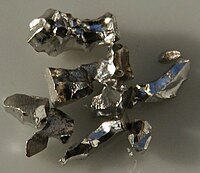
Photo from wikipedia
Ruthenium (Ru) complexes are known for their promising anticancer activity presumably due to octahedral coordination geometry, slow ligand exchange rate, the range of different oxidation states and target specificity. This… Click to show full abstract
Ruthenium (Ru) complexes are known for their promising anticancer activity presumably due to octahedral coordination geometry, slow ligand exchange rate, the range of different oxidation states and target specificity. This review article summarizes the physicochemical processes which are responsible for the selectivity of Ru complexes toward cancer cells over the normal cells. Emphasis has been given on the activation mechanism of Ru(III) complex administered as a prodrug and then the release of active species in an acidic environment of cancer cell through normal or photo induced hydrolysis or ligand oxidation. This article also elaborates how active Ru complex can be designed by their rate of hydrolysis, kinetics of ligand exchange, pKa of the aquated species. The article further articulates how Ru complexes inhibit tumor growth via multiple events such as transferrin/albumin binding, ROS generation, inhibition of glutathione-S-transferases and kinases and DNA intercalation. Based on the above understanding, examples of various Ru complexes with their in-vitro cell based cytotoxicity and mechanism of action have been described to make this review comprehensive for future Ru based anticancer drug development. In the end, comments have been made on some emerging concepts regarding lack of innertness of Ru(III) complexes vis-à-vis Ru(II) species.
Journal Title: European journal of medicinal chemistry
Year Published: 2018
Link to full text (if available)
Share on Social Media: Sign Up to like & get
recommendations!